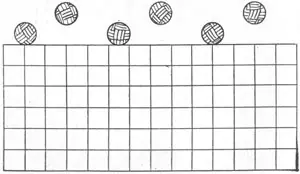Dear readers of our portal “fitness, bodybuilding in Russian”, in this article we will continue the story about: with the help of what devices and technical solutions is produced special physical training for volleyball players…
Content- "Drawn net" for training in volleyball.
- A device for improving ball passing in volleyball.
- Special training for a volleyball player on the device: “Ball on a snap.”
- Ball on a movable rod.
"Drawn net" for training in volleyball.
The device is designed to teach and improve blocking in volleyball.
On the wall of the gym (Fig. 1) “nets” are drawn at different heights (one for men, the other for women), above which drawn balls are also located at different heights. The length of the drawn grid is 2…3 m.
Athletes are located in columns, one opposite "drawn grid". The number of columns corresponds to the training task - single, double or triple blocking. At the coach’s command, special physical training of volleyball players begins to practice defense, and the first numbers from each column move towards the “net”, perform blocking and, after several repetitions, go to the end of the column.
A device for improving ball passing in volleyball.
The device allows you to improve special ball passing techniques for volleyball players of various qualifications.
The device (Fig. 2) consists of a sliding stand 1 mounted on a metal stand 3. A ring 2 with a diameter of 80 cm is attached to the stand. The ring can be installed:
- in a vertical position,
- in a horizontal position.
The device can be installed near the net, as well as anywhere in the gym. Volleyball player training on this device is performed both individually and collectively - by the whole group at once. At the stage of initial training of athletes and their mastering of passing skills, it is recommended to use rings of larger diameter. When volleyball players work on this device, the teacher must take into account the preparedness of the players and, taking this into account, select exercises based on complexity and dosage. The pass to the hoop by a trained volleyball player can be differentiated by flight speed, trajectory, direction and range.
The device allows you to produce in the simplest conditions hitting the ball by any technical method.
The device includes a beam with balls suspended from it. To ensure that the suspended ball retains the ability to fly, you can use an ordinary metal clip. The latch is hooked into the pile of the ball and it is easily released under the influence of a blow.
In balls without pressure, instead of clips, you can use a small rod (diameter 3...4 mm, height up to 10 mm), which is inserted into a drilled hole in the ball. Balls without pressure with holes do not lose their elastic properties. The hole area can be painted over with bright paint.
The device for specialized physical training of a tennis player has much in common with the volleyball machines we reviewed. Let's look at one of these devices...Ball on a movable rod.
The device is designed to improve movements in the complex training of a tennis player. At the moment of interaction of the racket with the ball, it allows you to hit the ball with full amplitude, thereby developing physical strength and sharpness of the striking movement...
The device (Fig. 3) consists of a pipe sleeve 1, a sliding bearing 2, a rod 3, a tennis ball 4, an elastic band 5. The pipe sleeve, approximately 25 cm long, is equipped with sliding bearings on both sides. A rod 75...80 cm long (made of a light alloy rod or pipe with a diameter of 8...10 mm) moves freely along them; a tennis ball is attached to one of its ends. There are different options for attaching the ball. The opposite end of the rod is connected to the sleeve-pipe with an elastic band of sufficient length.
In the initial position, the rod with the ball is extended towards the tennis player. The ball is located at the point needed to hit. The athlete hits the ball, the rod, under the influence of the blow, moves along the guide sleeve. Then the tensioned rubber band returns the rod to its original position.
Post Views: 135


